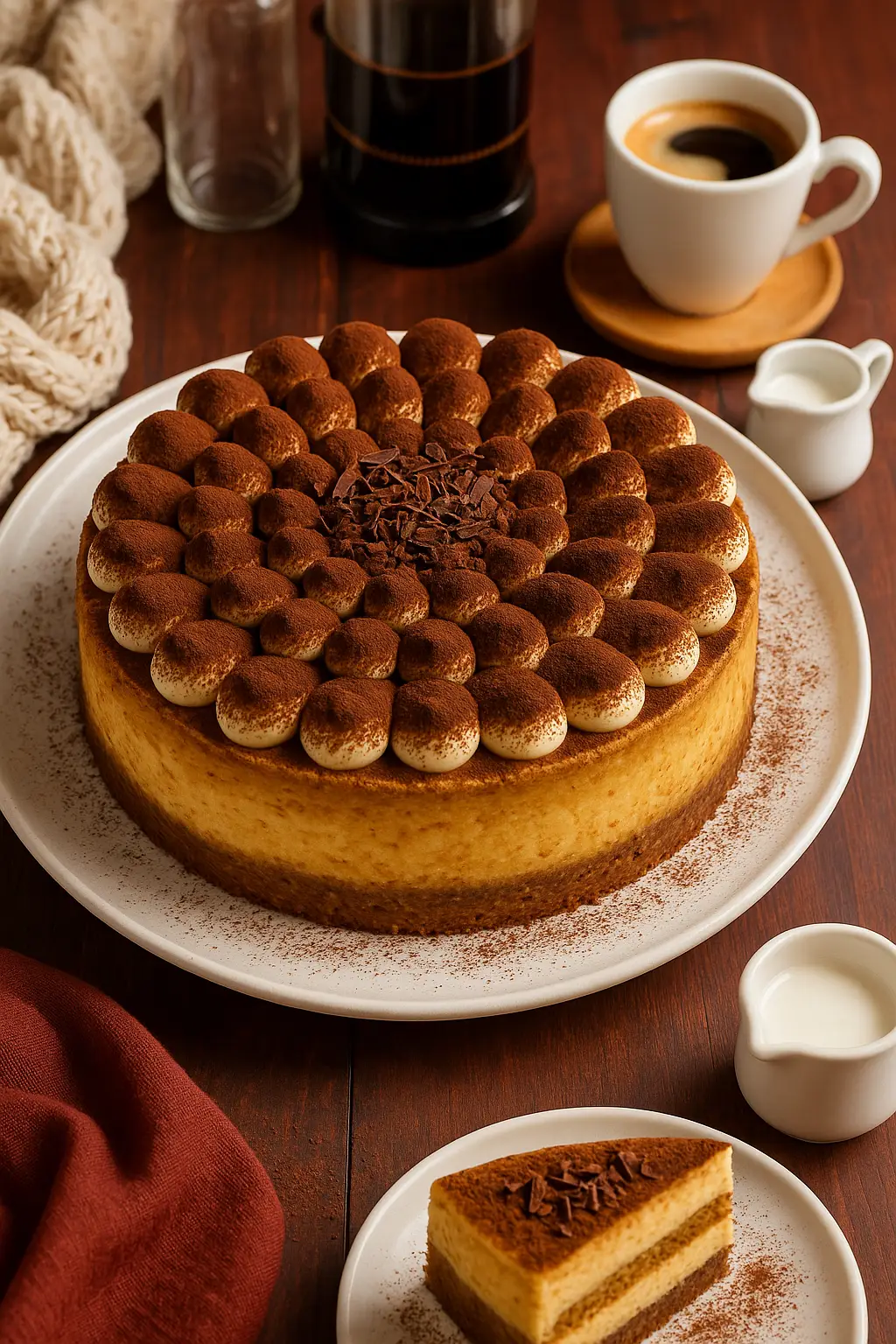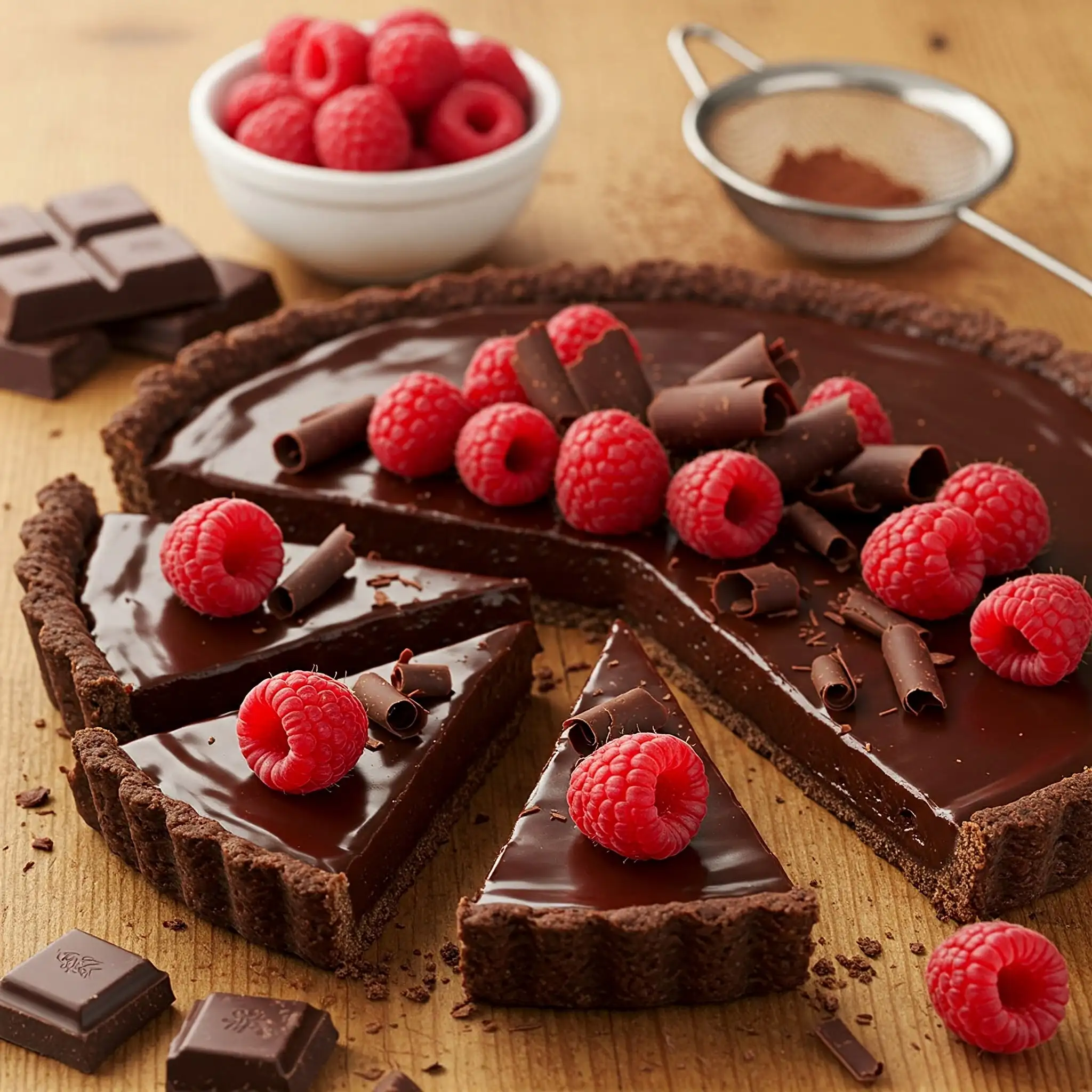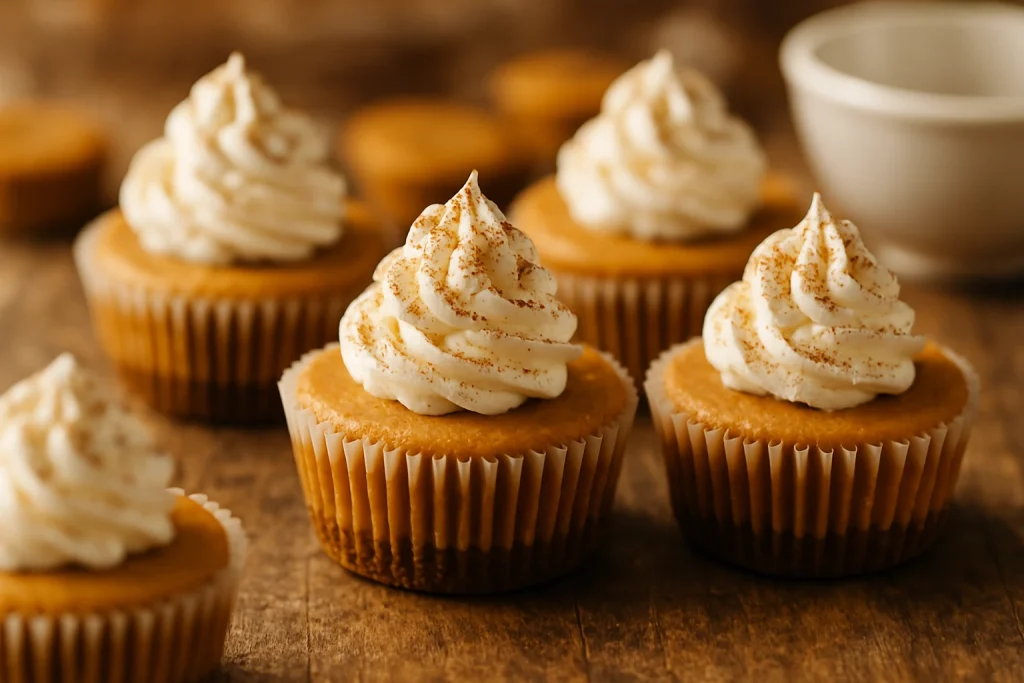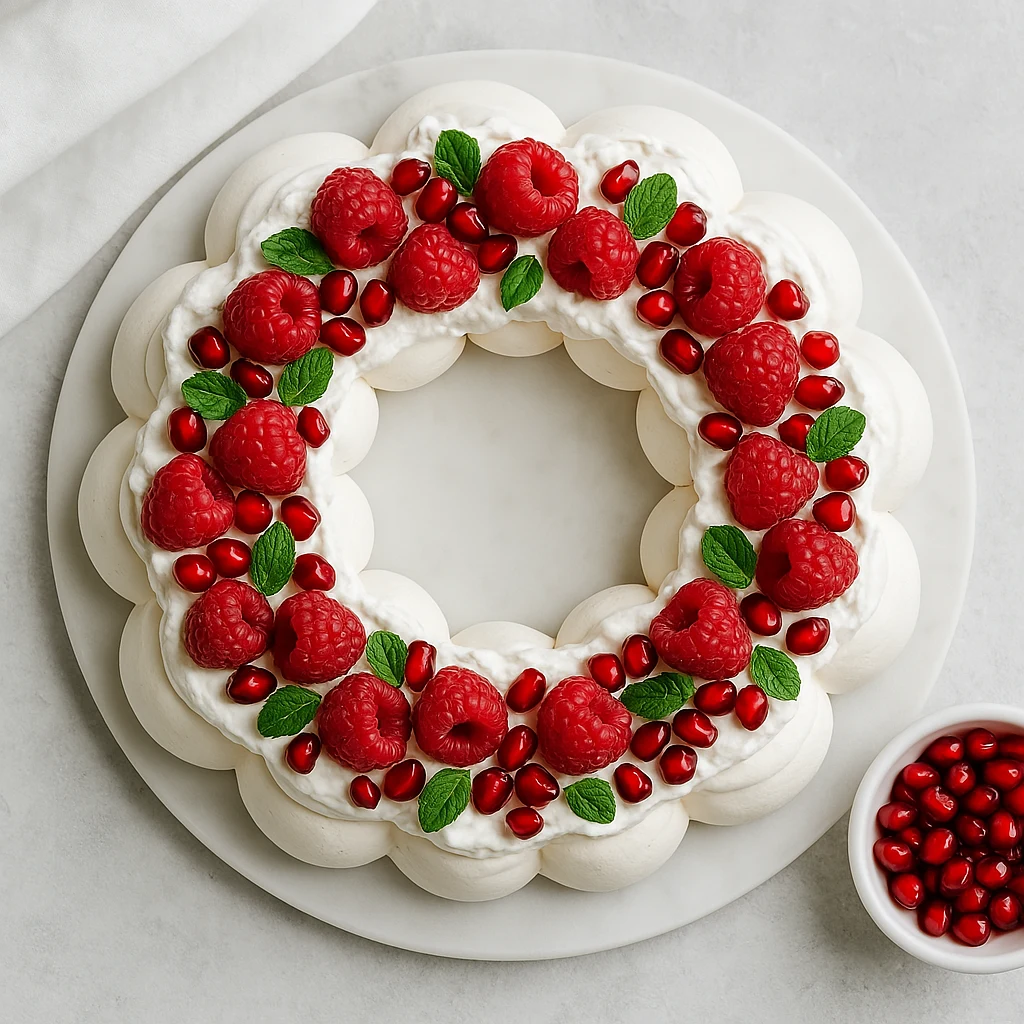Rosewater Pistachio Panna Cotta
This Rosewater Pistachio Panna Cotta marries the gentle luxury of rosewater—a treasured ingredient in Middle Eastern and Persian cuisines for centuries—with the subtle earthiness of pistachios. The result? A dessert that impresses with its sophistication yet requires surprisingly little effort to create. Each spoonful offers a delicate balance: creamy sweetness, subtle floral notes, and the satisfying crunch of verdant pistachios.
Don’t be intimidated by its elegant appearance. With careful attention to a few key techniques, you’ll create a dessert worthy of the finest restaurant table—right in your own kitchen.
Why This Rosewater Pistachio Panna Cotta is Good
- Uniquely Sophisticated Flavor Profile: The marriage of delicate rosewater and nutty pistachios creates an exotic yet approachable taste experience
- Silky Smooth, Melt-in-Your-Mouth Texture: Achieve the perfect wobble—firm enough to hold its shape but tender enough to dissolve effortlessly
- Elegant Presentation: With minimal effort, create a dessert that looks as exquisite as it tastes
- Surprisingly Simple to Make: Despite its refined appearance, requires just a handful of ingredients and no baking
- Naturally Gluten-Free: Perfect for accommodating dietary restrictions without compromise
- Make-Ahead Marvel: Prepare up to two days in advance for stress-free entertaining
The magic of this rosewater pistachio panna cotta lies in its delicate balance. Rosewater, with its intensely floral character, must be measured with precision—too little disappears into the cream, too much transforms your dessert into something reminiscent of perfume. The pistachios provide more than just visual contrast; their gentle nuttiness anchors the ethereal floral notes, creating a dessert that feels both grounded and transcendent.
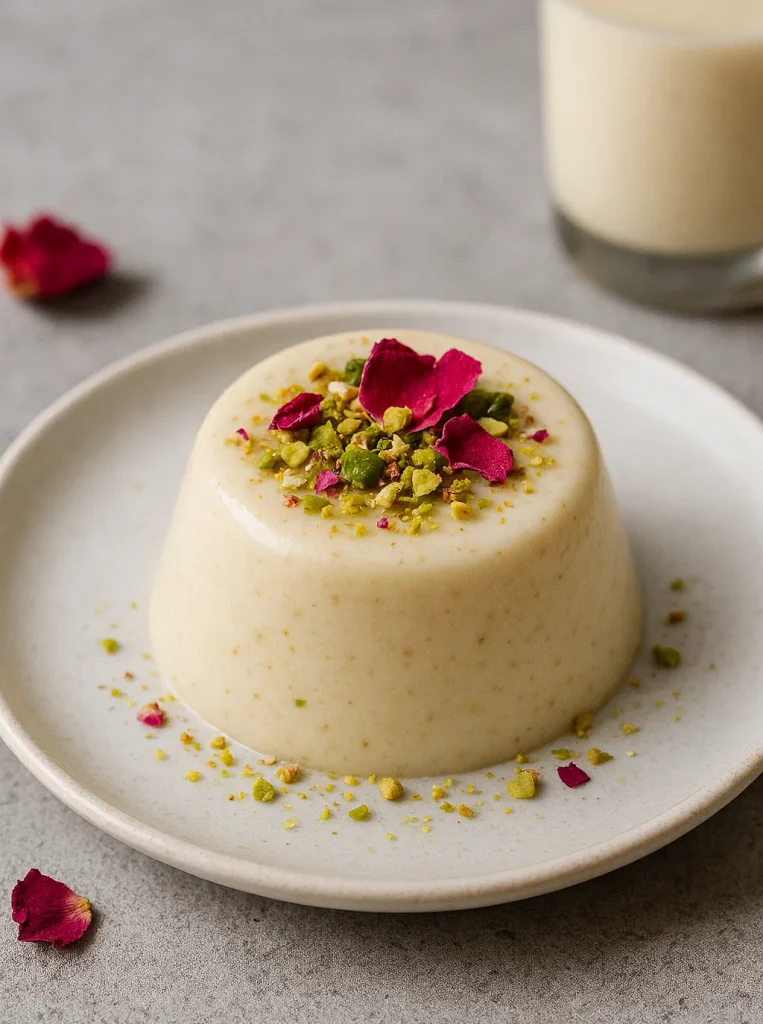
Rosewater Pistachio Panna Cotta Recipe Review
Baking Time and Nutrition Facts
6 Pannas
20 Minutes
6 Hours
325 Kcal
13g
16g
6H20Minutes
5g
Essential Tools:
- Medium saucepan
- Fine-mesh strainer
- Measuring cups and spoons
- Mixing bowls
- Whisk
- Rubber spatula
- 6 serving vessels
Rosewater Pistachio Panna Cotta Ingredients
Key Ingredients
- For the Panna Cotta:
2 cups (480ml) heavy cream (36% fat)
1 cup (240ml) whole milk (3.5% fat)
⅓ cup (67g) granulated sugar
2¼ teaspoons (7g) powdered gelatin (or 4 silver-grade gelatin sheets)
3 tablespoons cold water (for blooming gelatin)
1-2 teaspoons high-quality food-grade rosewater (start with less, add more to taste)
¼ teaspoon pure vanilla extract (optional, adds depth)
Pinch of fine sea salt
¼ cup (32g) finely chopped raw, unsalted pistachios (plus more for garnish)
- For Garnish:
¼ cup (32g) roughly chopped or slivered pistachios, lightly toasted
1 tablespoon dried culinary rose petals (ensure they’re food-grade)
Light drizzle of honey (optional)
Critical Patissier Notes:
Setting Agent: The precise amount of gelatin is crucial for achieving that perfect “wobble.” The 2¼ teaspoons of powdered gelatin specified here creates a delicate set that trembles when touched but still holds its shape. Bloom the powdered gelatin in cold water for 5 minutes until it resembles a soft gel before incorporating. If using sheet gelatin, soak in very cold water for 5-10 minutes until soft, then squeeze out excess water before dissolving.
Rosewater: This is where quality truly matters. Seek out high-quality food-grade rosewater from Middle Eastern markets or specialty food stores. The intensity can vary dramatically between brands, so start with just 1 teaspoon, then taste the cream mixture (before adding gelatin) and adjust. Remember: you can always add more, but you cannot remove it once it’s mixed in. When balanced correctly, rosewater should provide a gentle floral whisper, not an overwhelming perfume.
Pistachios: Raw, unsalted pistachios provide the purest flavor. Toasting them briefly enhances their nuttiness—simply spread on a baking sheet and toast at 325°F (165°C) for 5-7 minutes until fragrant. For incorporating into the cream, chop them very finely; for garnish, a rougher chop provides textural contrast.
Dairy: The combination of heavy cream and whole milk creates the perfect richness. You can adjust the ratio slightly for a lighter or richer result, but avoid low-fat options—they simply won’t deliver the luxurious mouthfeel that defines a proper panna cotta.
Sweetness: Panna cotta should be subtly sweet, allowing the delicate flavors to shine. The ⅓ cup sugar specified here achieves this balance, but you can adjust slightly to taste.
Step-by-Step: Rosewater Pistachio Panna Cotta
Instructions
- Prepare your vessels: Select 6 serving glasses, ramekins, or traditional panna cotta molds (approximately 4oz/120ml each). If you plan to unmold the panna cotta rather than serve in glasses, lightly grease the molds with a neutral oil.
- Bloom the gelatin: Pour the cold water into a small bowl and sprinkle the powdered gelatin evenly over the surface. Allow it to sit undisturbed for 5 minutes until it becomes a soft gel. (If using sheet gelatin, submerge sheets in a bowl of very cold water for 5-10 minutes until soft and pliable.)
- Create the base: In a medium saucepan, combine the heavy cream, whole milk, sugar, and salt. Warm over medium-low heat, stirring occasionally to dissolve the sugar. Do not allow the mixture to boil—you want it hot but not simmering, around 170°F (77°C) if using a thermometer.
- Incorporate the gelatin: Once the cream mixture is hot and the sugar completely dissolved, remove from heat. If using powdered gelatin, add the bloomed gelatin directly to the hot cream mixture. If using sheet gelatin, squeeze excess water from the softened sheets and add to the hot cream. Stir gently but thoroughly until the gelatin is completely dissolved, about 2 minutes.
- Add flavorings: Allow the mixture to cool slightly for 2-3 minutes, then add 1 teaspoon of rosewater and the vanilla extract (if using). Stir gently, then taste. Add additional rosewater if desired, but be cautious—it’s powerful.
- Strain for perfection: Pour the mixture through a fine-mesh sieve into a clean pouring vessel (like a large measuring cup). This crucial step removes any undissolved gelatin particles or potential milk solids, ensuring perfect smoothness.
- Add pistachios (optional): If incorporating pistachios into the base (rather than just as garnish), stir the finely chopped nuts into the strained mixture.
- Pour and chill: Carefully divide the mixture among your prepared vessels. Cover each with plastic wrap and refrigerate for at least 6 hours, though overnight is ideal for the perfect set.
Tips for Perfect Rosewater Pistachio Panna Cotta
The Perfect Wobble: The hallmark of an excellent panna cotta is its texture—firm enough to hold its shape when unmolded, yet so delicate it quivers with the slightest movement. When gently nudged with a spoon, it should wobble like a silk scarf in a soft breeze. This requires precision with your gelatin. Our recipe finds the sweet spot, but if you prefer a firmer set, add an additional ¼ teaspoon of powdered gelatin.
Smooth Operator: To avoid the disappointment of finding tiny lumps in your silken dessert, be vigilant about properly blooming the gelatin (it should look like applesauce before you add it). Never boil the cream mixture—high heat can damage gelatin’s setting properties. And always, always strain the final mixture before pouring into molds.
Flavor Finesse: Rosewater is potent and can quickly overwhelm. The difference between delicate floral notes and feeling like you’re eating potpourri is literally drops. Add it gradually, tasting as you go. Remember that the flavor will become slightly more pronounced as the panna cotta sets.
Setting Success: Ensure your refrigerator is properly cold (below 40°F/4°C). Place your filled molds on a level shelf where they won’t be disturbed. Patience is key—rushing the setting process by freezing will destroy the delicate texture.
Unmolding Magic: If serving unmolded (rather than in glasses), run a thin knife around the edge of each mold. Dip the mold briefly (just 3-5 seconds) in hot water, place your serving plate on top, then invert quickly. If it doesn’t release immediately, repeat the hot water dip—don’t be tempted to leave it in the hot water too long or your carefully crafted texture will suffer.
A Touch of the Exotic: Rosewater & Pistachios
Rosewater carries the essence of hundreds of rose petals, distilled into a clear, fragrant liquid that has perfumed Middle Eastern and Mediterranean cuisine for millennia. Beyond its culinary applications, rosewater has been prized in traditional medicine and beauty rituals across Persian, Indian, and Arabic cultures. In many Middle Eastern homes, offering rose-scented treats to guests is a gesture of hospitality and respect—a tradition you’ll channel when serving this elegant dessert.
Pistachios, with their vibrant green hue and distinctive flavor, are equally storied. Native to regions stretching from Central Asia to the Middle East, these gems have been cultivated for at least 9,000 years. Their presence in baklava, halva, and countless other sweets speaks to their perfect affinity for desserts. Beyond their flavor, pistachios symbolize happiness and good fortune in many cultures—a fitting inclusion for a dessert meant for celebration.
Together, these ingredients transform a simple Italian panna cotta into a dessert that whispers of ancient spice routes and royal Persian gardens.
Serving & Garnishing Elegantly
For maximum impact, serve your panna cotta well-chilled but not ice-cold—about 15 minutes out of the refrigerator allows the flavors to bloom fully on the palate.
If serving in glasses, create visual layers by adding the chopped pistachios just before serving, preventing them from sinking into the cream. Scatter a few dried rose petals across the surface, their deep crimson providing striking contrast against the pale cream and green pistachios.
For unmolded presentations, place each panna cotta in the center of a chilled dessert plate. Create a crescent of chopped pistachios alongside, scatter rose petals around, and perhaps add a few fresh berries for color contrast if desired. A whisper-thin drizzle of honey adds a final touch of gleaming elegance.
Provide small dessert spoons rather than larger ones—this dessert deserves to be savored in delicate bites.
Storing Your Rosewater Pistachio Panna Cotta
This rosewater pistachio panna cotta keeps beautifully when properly stored, making it an ideal make-ahead dessert for entertaining. Keep them refrigerated and covered with plastic wrap pressed directly against the surface to prevent a skin from forming.
For optimal texture and flavor, enjoy within 2-3 days. While technically safe to eat beyond this timeframe, the delicate texture begins to deteriorate, and the gelatin may start to weep slightly. This dessert doesn’t freeze well—the delicate structure that gives panna cotta its characteristic texture breaks down when thawed.
If garnishing with pistachios and rose petals, add these just before serving to maintain their visual appeal and textural contrast.
FAQs About Rosewater Pistachio Panna Cotta
Q: My panna cotta didn’t set firmly enough. What went wrong? A: The most common culprit is insufficient gelatin or not allowing enough chilling time. Ensure you measured the gelatin precisely and gave it at least 6 hours (preferably overnight) to set. Also check that your gelatin isn’t expired, as its setting power diminishes over time.
Q: Help! My panna cotta is too firm and rubbery. A: Too much gelatin is the likely cause. Next time, reduce the amount by ¼ to ½ teaspoon. Also ensure you’re not boiling the cream mixture, as excessive heat can affect gelatin’s properties.
Q: The rosewater flavor is overwhelming. Can I fix it? A: Unfortunately, once set, it’s difficult to adjust the flavor. For future batches, start with half the amount and increase gradually. Different brands vary significantly in potency.
Q: Can I make this dairy-free? A: Yes! Substitute the dairy with full-fat coconut milk (the canned variety). The flavor will complement both the rosewater and pistachios beautifully. You may need to adjust the gelatin slightly—coconut milk sometimes requires a touch more to achieve the same set.
Q: How far in advance can I make this? A: For optimal results, prepare up to 48 hours ahead. Keep covered and refrigerated until ready to garnish and serve.
An Elegant Rosewater Pistachio Panna Cotta
In this Rosewater Pistachio Panna Cotta, we’ve created more than just a dessert—we’ve crafted an experience that engages all the senses. The gentle tremble as your spoon breaks the surface, the delicate aroma of roses, the visual poetry of cream, green, and crimson, and finally, the luxurious mouthfeel and harmonious flavors.
What appears impressively sophisticated requires remarkably little technical skill—just attention to detail and quality ingredients. This is the beauty of panna cotta: maximum impact with minimal effort. Whether concluding an intimate dinner for two or a gathering of your most discerning friends, this dessert speaks of thoughtfulness and culinary finesse.
Have you ever worked with rosewater in your kitchen? What special occasion would inspire you to create this elegant finale? Share your creations and tag us—we’d love to see your take on this timeless treasure.


